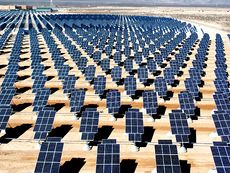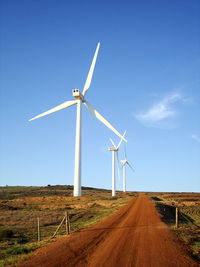Non-dispatchable source of electricity: Difference between revisions
J.williams (talk | contribs) No edit summary |
J.williams (talk | contribs) m (1 revision imported) |
(No difference)
| |
Revision as of 21:31, 26 August 2015
A non-dispatchable source of electricity is a generator of electrical energy that cannot be turned on or off in order to meet societies fluctuating electricity needs. It is the opposite of dispatchable sources of electricity which are very flexible, being able to change their output fairly quickly in order to meet electricity demands. Non-dispatchable electricity sources are often highly intermittent, which means that they are not continuously available due to factors outside direct control. There are many different types of non-dispatchable sources such as tidal power and wave power,[1] but two main types that contribute noticeably to the electrical grid: Solar power and wind power.
Solar power

Solar power is intermittent and most often non-dispatchable. Solar energy to the Earth is not the same in all locations, and is also affected by cloud cover. The main reason that solar power is non-dispatchable however is the fact that the Sun does not shine for all hours of the day in a given location.[3] Therefore it is impossible to make consistent use of this resource for electricity generation without the use of electricity storage.
Since the length of days and weather effects are fairly predictable, there are power plants that use heat storage from the solar energy in order to produce power when the sun isn't shining.
Wind power

Wind power is considered highly intermittent and non-dispatchable because it is a variable power source, meaning that its electrical output depends on many factors, such as wind speed, air density, turbine characteristics, and more. All of these factors also change depending on location of the site. Wind speed must also be in a certain range (depending on the turbine), above 3.5 m/s in order to generate electricity, and below 25 m/s to avoid damage to the turbine.[5] When taking multiple wind farm's intermittency into consideration, it would make sense that the reliability would somewhat increase, but this actually doesn't appear to be the case.[6]
References
- ↑ EDF Energy, Wave power is intermittent but tide power is predictable [Online], Available: http://www.edfenergy.com/energyfuture/energy-gap-reliability/marine-and-the-energy-gap-reliability
- ↑ Wikimedia Commons [Online], Available: http://upload.wikimedia.org/wikipedia/commons/4/45/Giant_photovoltaic_array.jpg
- ↑ Renewable Energy World, Solar Intermittency: How Big is the Problem? [Online], Available: http://www.renewableenergyworld.com/articles/2011/11/solar-intermittency-how-big-is-the-problem.html
- ↑ Wikimedia Commons [Online], Available: http://upload.wikimedia.org/wikipedia/commons/0/0d/Darling_Wind_Farm.jpg
- ↑ DASH, Meteorologically Defined Limits to Reduction in the Variability of Outputs from a Coupled Wind Farm System in the Central US [Online], Available: http://dash.harvard.edu/bitstream/handle/1/10981611/Meteorologically%20defined%20limits%20to%20reduction%20in%20the%20variability%20of%20outputs%20from%20a%20coupled%20wind%20farm%20system%20in%20the%20Central%20US_1.pdf?sequence=6
- ↑ David JC McKay, Sustainable energy - without the hot air [Online], Available: http://www.inference.phy.cam.ac.uk/withouthotair/c26/page_187.shtml

